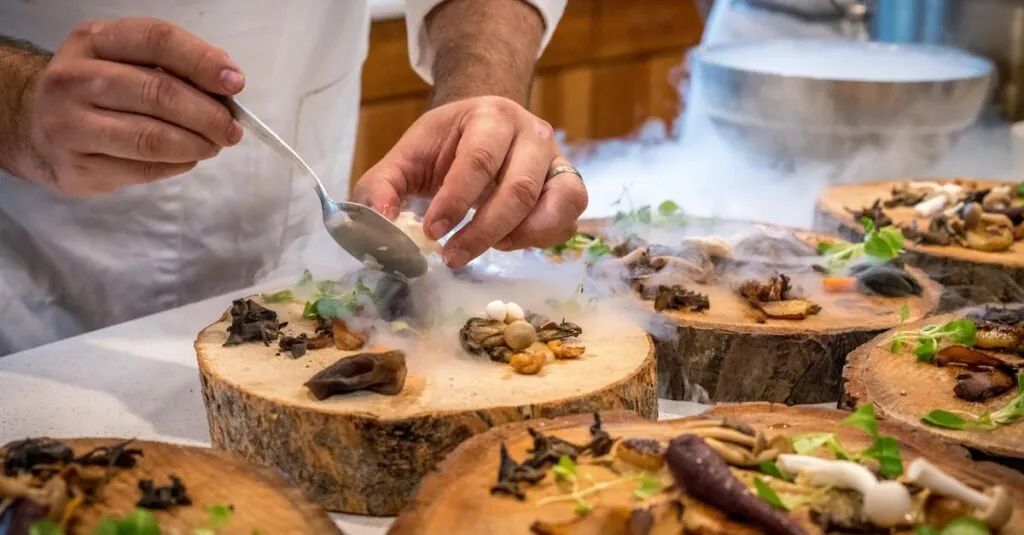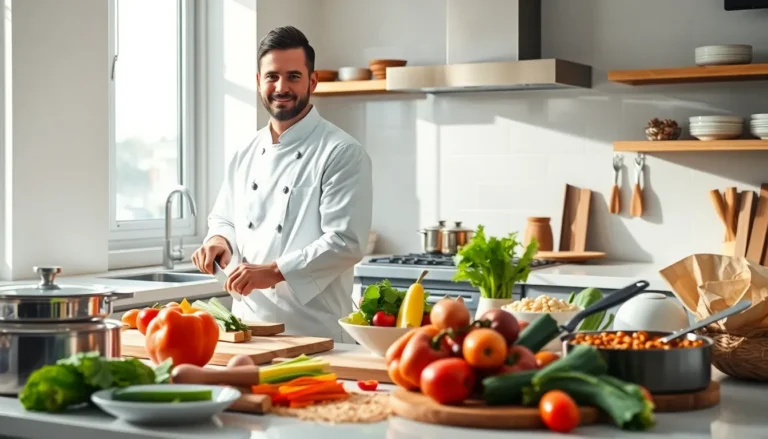Table of Contents
ToggleIn the culinary world, molecular cooking techniques are like a magic show where science meets the art of gastronomy. Imagine transforming everyday ingredients into whimsical delights that not only tantalize the taste buds but also spark curiosity. It’s the kind of cooking that makes you feel like a mad scientist in a kitchen lab, wielding tools that could rival any high-tech gadget.
Overview of Molecular Cooking Techniques
Molecular cooking techniques incorporate scientific principles to create innovative dishes. These methods emphasize texture, flavor, and presentation, transforming the dining experience. Spherification, for example, allows chefs to create caviar-like spheres from liquids. Gelling agents such as agar-agar provide alternatives to traditional cooking methods, reshaping how ingredients are combined and presented.
Emulsification forms stable mixtures, blending oil and water-based components. Chefs often utilize tools like immersion blenders and whippers to achieve desired textures. Foams and airs enhance dishes, providing lightness and complexity to flavors. Sous-vide cooking employs precise temperature control, ensuring consistent results and maximum flavor retention.
Chilling techniques, such as liquid nitrogen freezing, quickly transform ingredients, creating unique textures. Using infra-red or laser technology enables precise heating, which enhances the final product without losing moisture. Chefs explore the science behind flavor pairings to create harmonious combinations that surprise and delight.
Salt and sugar play crucial roles in molecular cooking, affecting the way flavors are perceived. Different salts may be used to enhance specific flavor profiles or alter textures. Techniques also involve the use of flavor-infused oils or powders that intensify taste without overwhelming the dish.
These techniques push culinary boundaries, creating dishes that are visually stunning and profoundly memorable. They challenge traditional cooking norms, inviting chefs to experiment and innovate. Embracing molecular cooking techniques opens new doors for creativity in both home and professional kitchens.
Popular Techniques in Molecular Cooking
Molecular cooking comprises several innovative techniques that revolutionize traditional culinary practices. Chefs embrace these methods to enhance flavor, texture, and presentation.
Spherification
Spherification is a popular technique that transforms liquids into caviar-like spheres. Chefs utilize sodium alginate and calcium chloride to achieve this effect. A liquid mixture gets dropped into a calcium bath, resulting in delicate spheres that burst with flavor when bitten. This technique provides an exciting experience for diners, making dishes visually stunning and interactive. Notable applications include fruit juices, sauces, and cocktails that surprise the palate.
Emulsification
Emulsification blends oil and water components into a cohesive mixture. Chefs often use ingredients like lecithin or mustard as emulsifiers for stability. This technique allows for the creation of smooth sauces and dressings that enhance the overall dining experience. Techniques vary from traditional methods like whisking to modern tools like immersion blenders. Emulsification creates airy textures, such as foams, which elevate the presentation of dishes and introduce new flavor profiles.
Sous Vide
Sous vide involves cooking vacuum-sealed food in a temperature-controlled water bath. Precise temperature control ensures even cooking, resulting in tender and flavorful dishes. This method allows chefs to prepare proteins and vegetables to their desired doneness without overcooking. The vacuum seal retains moisture and flavors, making it ideal for delicate ingredients. Sous vide techniques have become popular in both restaurants and home kitchens, providing a reliable way to achieve consistent results.
Equipment Used in Molecular Cooking
Molecular cooking requires specific tools that facilitate innovative preparation methods. Essential equipment helps chefs transform ingredients while enhancing taste and presentation.
Essential Tools
Precision is key in molecular cooking. Syringes enable accurate measurement and transfer of ingredients. Pipettes allow for controlled liquid drops in dishes. Immersion blenders create smooth textures and incorporate air. Whipping siphons produce foams using pressurized gas. Thermometers monitor exact temperatures, ensuring consistent results. Each of these tools plays a crucial role in achieving the desired outcomes.
Advanced Gadgets
Advanced gadgets elevate the art of molecular cooking. Sous-vide machines offer precise temperature control, allowing for even cooking while retaining moisture. Liquid nitrogen tanks facilitate rapid freezing, creating unique textures and shocking flavors. Rotary evaporators distill and concentrate flavors, enhancing dishes with potent essences. Laser thermometers provide instantaneous temperature readings, boosting efficiency in the kitchen. Each gadget enhances creativity and precision, pushing culinary boundaries further.
Benefits of Molecular Cooking Techniques
Molecular cooking techniques offer several advantages that enhance culinary experiences. Enhanced flavor profiles result from precise control over ingredient interactions. Chefs achieve unique textures, making dishes more enticing and memorable. Visual appeal increases with creative presentations that captivate diners.
Consistency in results benefits both professional chefs and home cooks alike. Through methods like sous-vide cooking, ingredients maintain moisture and flavors, ensuring reliable outcomes. Chefs can also experiment with new combinations, discovering innovative dishes that surprise and delight.
Additionally, molecular cooking encourages creativity in the kitchen. Techniques such as spherification and emulsification allow for artistic expression and presentation. Tools like immersion blenders and set additives expand what chefs can create, pushing culinary boundaries.
Health-conscious diners can enjoy this cooking style as well. By using flavor-infused oils and powders, they can enhance taste without added calories. Such modifications retain the integrity of dishes while focusing on nutritious ingredients.
Finally, molecular cooking promotes learning and exploration. Chefs gain knowledge of scientific principles, deepening their understanding of flavor dynamics and ingredient interactions. This fusion of science and art inspires ongoing culinary innovation, rewarding those willing to embrace molecular techniques.
Challenges and Considerations
Molecular cooking presents several challenges that chefs must navigate. Precision plays a crucial role in achieving the desired results; even slight variations in measurements can lead to unsatisfactory outcomes. Temperature control also requires careful attention, as the techniques often rely on specific heat settings for optimal flavor and texture.
Understanding ingredient interactions is vital to successful molecular cooking. Different components can react unpredictably when combined, causing alterations in flavor or texture. Chefs need knowledge of food science to anticipate how various ingredients will behave under specific conditions.
Access to specialized equipment creates additional challenges for chefs. Tools used in molecular cooking, like sous-vide machines or whipping siphons, may not be readily available in every kitchen. High costs associated with purchasing advanced gadgets can limit experimentation for some cooks.
Time management becomes essential when implementing molecular techniques. Many processes, such as spherification or sous-vide cooking, involve extended preparation times. Chefs must plan ahead to ensure that each element of a dish comes together seamlessly.
Training and experience also affect the successful execution of molecular cooking methods. Understanding how to use the equipment and techniques requires practice and dedication. Chefs should invest in learning opportunities to enhance their skills and creativity in this innovative culinary field.
Health considerations are another aspect of molecular cooking. Some techniques may introduce unfamiliar additives or allergens to dishes, necessitating caution when serving to sensitive diners. Chefs must communicate clearly about ingredients to provide a safe dining experience for their guests.
Molecular cooking techniques represent a groundbreaking fusion of culinary art and scientific innovation. These methods not only elevate traditional cooking but also inspire chefs to think outside the box and experiment with flavors and textures. By embracing precision and creativity, they can craft dishes that are as visually stunning as they are delicious.
While challenges exist in mastering these techniques, the rewards are substantial. Chefs who venture into the world of molecular gastronomy can create memorable dining experiences that captivate and delight. As the culinary landscape continues to evolve, molecular cooking stands out as a testament to the endless possibilities in the kitchen.



